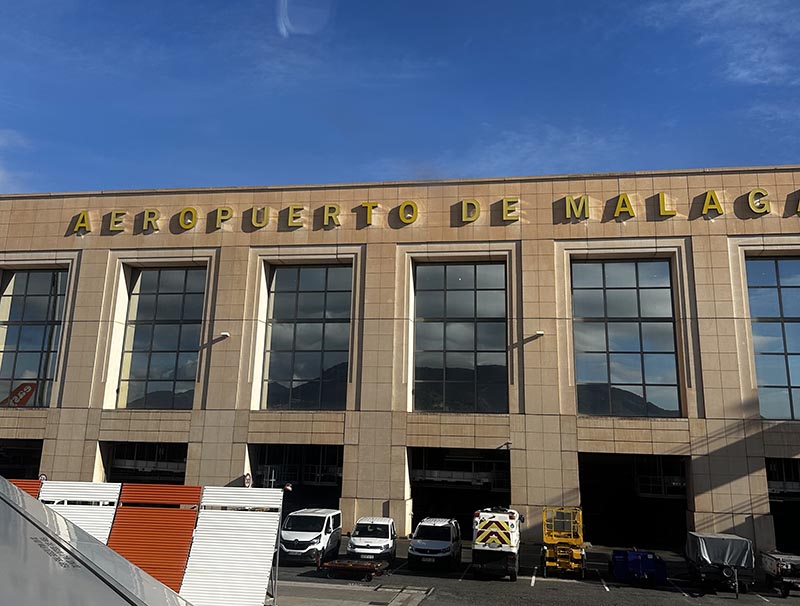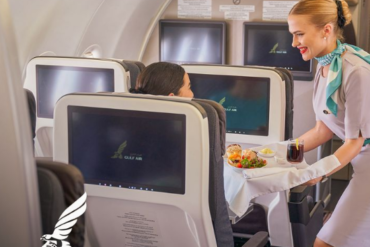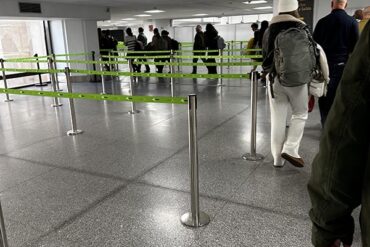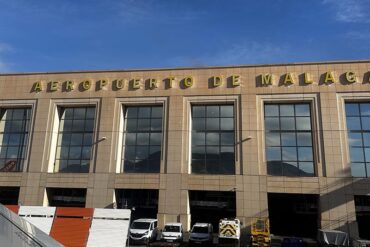
Malaga Airport Guide
Located on the popular tourist destination of the Costa del Sol, Malaga Airport is a vital gateway to the enchanting region of Andalucia. Its strategic location, just eight kms southwest of the beautiful city of Malaga, positions it as a bustling hub connecting travellers to a large number of national and international destinations.
Originally established in 1919 as a makeshift aerodrome, Malaga Airport has evolved into one of Spain’s busiest airports, serving as a crucial link between Europe and the Mediterranean. Over the years, it has undergone significant expansions and renovations to meet the growing demands of modern air travel.
The airport’s geographical advantage extends beyond its proximity to Malaga; it strategically positions itself for easy access to renowned tourist destinations along the Costa del Sol, including Marbella, Torremolinos, and Fuengirola. This accessibility has made Malaga Airport a pivotal point for tourists seeking the beaches, historic landmarks, and Spanish culture that characterise the Andalucian region.
Malaga Airport boasts an extensive network of connections, providing direct flights to a number of different destinations across Europe and beyond. Its role as a key transport hub is evident in the numerous airlines and routes it accommodates. Travellers can seamlessly reach major cities such as London, Paris, Berlin, and beyond, making it a gateway for both leisure and business travel.
Some official information about Malaga Airport that you might find useful
Málaga Airport, officially known as ‘Aeropuerto de Málaga-Costa del Sol’, serves as the gateway to southern Spain’s Costa del Sol, one of the most popular tourist destinations in Europe. The airport has undergone significant renovations over the years and continues to evolve to accommodate growing passenger numbers.
History and Renovations
Málaga Airport’s origins date back to 1919 when it was used as an airstrip for military purposes. Over the years, it evolved into a key transport hub for both Spain and international travellers. Its proximity to the city of Málaga and the popular tourist destinations along the Costa del Sol made it increasingly important, necessitating significant upgrades and expansions over the last few decades.
The first terminal building was inaugurated in 1948, but it wasn’t until the 1960s and 1970s that the airport began to experience a dramatic rise in passenger traffic due to the growing popularity of the Costa del Sol as a tourist destination. This rapid growth led to the construction of ‘Terminal 2’, which opened in 1991, significantly boosting the airport’s capacity.
However, by the early 2000s, it became evident that further expansion was necessary. In response, a third terminal, ‘Terminal 3’, was constructed and opened in 2010. Terminal 3 was a monumental development in the airport’s history, doubling the airport’s capacity to around 30 million passengers annually. The modern, spacious terminal boasts a sleek design, with improved check-in facilities, security areas, and baggage handling systems.
Alongside the opening of Terminal 3, the airport’s runway system was also upgraded to accommodate larger aircraft and to ease congestion. A ‘second runway’ was added in 2012, ensuring that Málaga Airport could handle the ever-increasing number of flights, especially during peak travel periods.
The airport’s train station, which connects Málaga with other cities along the Costa del Sol, was also improved as part of this modernisation. These upgrades have positioned Málaga Airport as a central hub for both holidaymakers and business travellers heading to southern Spain.
Family and Accessibility Services
Families traveling with young children will find a variety of services at Málaga Airport designed to make their journey easier. There are designated family areas, baby-changing facilities, and play zones for children.
The airport is also committed to providing an accessible environment for travellers with reduced mobility. Wheelchair services, accessible toilets, and priority lanes for security are just some of the facilities available.
Public Car Parking At Malaga Airport
The main official car parking at Malaga Airport is accessed on the lower level. Basically follow the signs for the car rentals and rather that taking the entrance to the rental section of the car park, keep driving and you will see the sign for the car park entrance.
This parking at Malaga Airport is on multiple levels and you can either take the rear exit to walk to the terminal or the front. Please note that there are only a few points you can now cross the road to the terminal.
To get to the Long Stay car park at Malaga Airport you need to go through the tunnel (basically stay left on the lower level) and you will then see the signs. It is much cheaper to pre-book and there is a regular shuttle bus to take you back to the airport.
A good tip is to look up the price of the main car park directly opposite the airport if you can book well in advance of your flight. Often the prices are very reasonable and if you become a member on the Aena website, you will get a discount.
Private Parking Malaga Airport
As you head to the airport there are a number of privately operated car parks which you can look up and pre-book. They are all cheaper (generally) than the normal airport car parks and they will operate a shuttle bus service to take you to the airport terminal and bring you back to you car upon your return.
Facilities at Malaga International Airport
Málaga Airport offers a wide range of facilities designed to enhance the traveller experience. Whether passengers are arriving, departing, or in transit, the airport provides modern conveniences to ensure a smooth journey.
Terminals and Check-in
Málaga Airport is divided into three terminals, though the majority of flights now operate from the newer ‘Terminal 3’. Terminal 2 is used mainly for seasonal and charter flights, while Terminal 1, which was once the main hub, is currently reserved for select regional and private flights.
Travellers will find a large, well-organised check-in area, with numerous self-service kiosks available for passengers wishing to check in quickly and easily. Security areas are designed to process a high volume of passengers efficiently, and ample seating is available in the departure lounges.
Shopping and Dining
Once past security, travellers can enjoy a range of shopping and dining options. ‘Duty-free shops’ offer everything from luxury goods, perfumes, and alcohol to local products and souvenirs.
There are also numerous dining options catering to a variety of tastes and budgets.
Lounges and VIP Services
For those seeking a more premium experience, Málaga Airport offers several ‘VIP lounges’. These lounges provide a quiet, comfortable space to relax before a flight, with complimentary food and drinks, free Wi-Fi, and charging stations for electronic devices. The lounges are available to business-class passengers, frequent flyers, and those who wish to pay for access.
List of the main bars and restaurants at Malaga Airport:
Public Side Of Malaga Airport
Burger King
Café Pans
La Manon
MasQMenos
Starbucks
Passenger Side Of Malaga Airport
BiBo Dani García Flamenco Bar & Tapas
Burger King
Caffè di Fiore
Costa Coffee
Café Pans
Dehesa Santa María
Eat
Foodies
Giraffe Stop
Giraffe World Kitchen
Jamie’s Deli
Kirey by Kabuki
La Boutique
MasQMenos
Olé Food Market
Soho Coffee CO
Starbucks
Journey Times From Malaga Airport:
Málaga Airport is well-connected to the city and surrounding areas through various transportation options.
- Trains: The ‘Cercanías C1’ train line runs directly from Málaga Airport to Málaga city centre, with stops at major coastal resorts like Torremolinos, Benalmádena, and Fuengirola. Trains operate frequently, making it a quick and cost-effective option for travellers.
- Buses: Several ‘bus services’ operate from the airport to Málaga city centre and other destinations along the Costa del Sol. There are also fast routes to central Málaga, while long-distance buses connect the airport with cities like Marbella and Estepona via different service options and for very low costs (approx. €5 to Marbella).
- Car Rental: Málaga Airport is home to numerous ‘car rental companies’, including Hertz, Europcar, and Sixt. Renting a car is a popular option for those looking to explore the Costa del Sol at their own pace. The car rental desks are located in the arrivals area, and the airport offers ample parking options for both short and long-term stays.
- Taxis: ‘Taxis’ are readily available outside the arrivals area, and journeys to central Málaga typically take around 15 minutes. Taxi fares are regulated, and rates are displayed in the vehicles to ensure transparency.
- Private Transfers: For a more personalised service, many visitors opt for ‘private airport transfers’ These can be booked in advance and offer a more comfortable and direct route to resorts such as Marbella, Nerja, or Estepona.
Location and Major Transport Links
Málaga Airport is conveniently located just 8 kilometers southwest of Málaga city center, making it easily accessible for both tourists and locals. Its proximity to the A7 motorway, the main coastal road along the Costa del Sol, ensures excellent transport links to the region’s most popular resorts.
Torremolinos is just 15 minutes away by car or train.
Benalmádena can be reached in 20 minutes.
Fuengirola is 30 minutes by train or taxi.
Marbella is approximately 45 minutes by car or bus.
Estepona is just over an hour’s drive away.
These transport links make Málaga Airport a central hub for millions of tourists who flock to the Costa del Sol every year.
Taxi Rank at Malaga Airport
The main taxi rank serving Malaga Airport is located outside of the main arrivals area to the right. There is normally a queue to get a taxi but it does seem to move quite quickly as there is a constant flow of taxis coming and going.
If you are being dropped off by taxi then please note you will be taken to the main departures areas on the floor above as there is a drop off area.
Passing Through Security at Malaga Airport
The security area is located at the far end of terminal 3. It has a series of barriers that will guide you to the screening area. You must show your boarding pass to enter this section and then follow the local instructions on what items need to be put into the trays for screening.
In the summer months of July and August this area can get quite busy and although you will still go through fairly quickly, you should consider allowing extra time just in case of hold ups and delays
Passport Control at Malaga Airport
You will not need your passport until you are heading to your actual departure gate, once it has appeared on the screen. As you leave the main departure lounge there is a passport control area. If you are a Spanish resident you should by now have a TIE card, which is the preferred way to prove you are a resident and therefore not have your passport stamped on departure or arrival. The green resident cards are still valid but many passport officials will stamp your passport if you don’t have a TIE, even though they are not meant to.
When you arrive at Malaga Airport from overseas, the passport control is at the end of the walk from the plane just before you get to the luggage collection area.
UK residents will not be subject to the stamping of passports on departure and entry.
Passenger Numbers in 2024
As of 2024, Málaga Airport continues to be one of Spain’s busiest airports, with passenger numbers steadily rising. By the end of 2023, it was projected that more than ‘20 million passengers’ would pass through the airport, a significant recovery from the declines seen during the COVID-19 pandemic. The summer of 2024 is expected to further boost these numbers, driven by the surge in holidaymakers returning to Spain’s southern coast and from an ever increasing number of destinations in Eastern Europe, USA and even China.
One of the key factors contributing to the airport’s growing traffic is the continued increase in low-cost carriers and budget airlines operating routes to and from Málaga. Airlines such as Ryanair, easyJet, and Vueling have expanded their offerings, making it easier than ever for tourists from across Europe and beyond to reach the Costa del Sol.
The airport serves a wide range of international destinations, with direct flights to major European cities like London, Paris, Berlin, and Amsterdam, as well as long-haul routes to New York and Doha. Additionally, domestic flights connecting Málaga with cities such as Madrid, Barcelona, and Palma de Mallorca remain popular.



